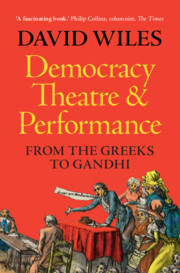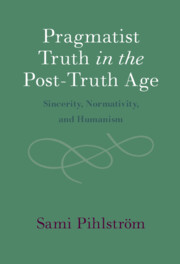Refine search
Actions for selected content:
22 results
Chapter 3 - Emerson and Skepticism
-
- Book:
- Emerson, the Philosopher of Oppositions
- Published online:
- 20 November 2025
- Print publication:
- 22 January 2026, pp 50-65
-
- Chapter
- Export citation
The anxious a priori: an essay concerning science, law, and the temporal politics of the Anthropocene polycrisis
- Part of
-
- Journal:
- Global Sustainability / Volume 8 / 2025
- Published online by Cambridge University Press:
- 20 October 2025, e49
-
- Article
-
- You have access
- Open access
- HTML
- Export citation
Shnur ‘Against Sincerity’: Aesthetics of Imperfection and Sincerity Anxieties in Twenty-First-Century Pop Culture
-
- Journal:
- Popular Music , First View
- Published online by Cambridge University Press:
- 08 September 2025, pp. 1-21
-
- Article
-
- You have access
- Open access
- HTML
- Export citation
“How Will I Know?”: Semiotic Indeterminacy, Transparency, and Expectations of Sincerity in the Global Nuclear Order
-
- Journal:
- Signs and Society / Volume 13 / Issue 1 / March 2025
- Published online by Cambridge University Press:
- 28 January 2025, pp. 43-59
-
- Article
-
- You have access
- Open access
- HTML
- Export citation
13 - Liturgical Philosophy of Religion
- from Part IV - Forms and Functions of Worship
-
-
- Book:
- The Philosophy of Worship
- Published online:
- 09 January 2025
- Print publication:
- 23 January 2025, pp 229-254
-
- Chapter
- Export citation
Chapter 2 - Acting versus Sincerity
-
- Book:
- Democracy, Theatre and Performance
- Published online:
- 17 May 2024
- Print publication:
- 27 June 2024, pp 39-62
-
- Chapter
- Export citation

Democracy, Theatre and Performance
- From the Greeks to Gandhi
-
- Published online:
- 17 May 2024
- Print publication:
- 27 June 2024
4 - Baruch Spinoza and Conscientious Speech
-
- Book:
- The Coerced Conscience
- Published online:
- 07 December 2023
- Print publication:
- 21 December 2023, pp 69-90
-
- Chapter
- Export citation
Voting under time pressure
-
- Journal:
- Judgment and Decision Making / Volume 17 / Issue 5 / September 2022
- Published online by Cambridge University Press:
- 01 January 2023, pp. 1072-1093
-
- Article
-
- You have access
- Open access
- HTML
- Export citation
Chapter 11 - After Analysis
- from Part II - Ideas
-
-
- Book:
- David Foster Wallace in Context
- Published online:
- 18 November 2022
- Print publication:
- 01 December 2022, pp 119-128
-
- Chapter
- Export citation
Chapter 17 - David Foster Wallace and Existentialism
- from Part II - Ideas
-
-
- Book:
- David Foster Wallace in Context
- Published online:
- 18 November 2022
- Print publication:
- 01 December 2022, pp 181-191
-
- Chapter
- Export citation
6 - Principled Pragmatists, Principled Purists, and the Liberal Democratic Front
-
- Book:
- Hanging Together
- Published online:
- 07 July 2022
- Print publication:
- 21 July 2022, pp 95-114
-
- Chapter
- Export citation
Introduction
-
- Book:
- Pragmatist Truth in the Post-Truth Age
- Published online:
- 14 September 2021
- Print publication:
- 23 September 2021, pp 1-11
-
- Chapter
- Export citation
Conclusion
-
- Book:
- Pragmatist Truth in the Post-Truth Age
- Published online:
- 14 September 2021
- Print publication:
- 23 September 2021, pp 218-225
-
- Chapter
- Export citation

Pragmatist Truth in the Post-Truth Age
- Sincerity, Normativity, and Humanism
-
- Published online:
- 14 September 2021
- Print publication:
- 23 September 2021
Chapter 2 - Stylistic Virtue between Moralism and Aestheticism
-
- Book:
- Stylistic Virtue and Victorian Fiction
- Published online:
- 11 June 2021
- Print publication:
- 01 July 2021, pp 47-71
-
- Chapter
- Export citation
Chapter 2 - Invigorating Women
- from Part I - Politics of Ability
-
- Book:
- Physical Disability in British Romantic Literature
- Published online:
- 09 November 2020
- Print publication:
- 12 November 2020, pp 65-97
-
- Chapter
- Export citation
Chapter 1 - Rhetoric
- from Part I - Contexts
-
-
- Book:
- Shakespeare and Emotion
- Published online:
- 01 October 2020
- Print publication:
- 22 October 2020, pp 19-33
-
- Chapter
- Export citation
3 - “Wicked Tongues and Wayward Behavior”
-
- Book:
- Puritans Behaving Badly
- Published online:
- 02 May 2020
- Print publication:
- 21 May 2020, pp 69-94
-
- Chapter
- Export citation
Chapter 8 - For Real? The Critique of TV Culture in the Short Fiction of Robert Coover and David Foster Wallace
- from Part III - Literary Immediacy and Television
-
- Book:
- American Literature and Immediacy
- Published online:
- 19 December 2019
- Print publication:
- 16 January 2020, pp 184-210
-
- Chapter
- Export citation
